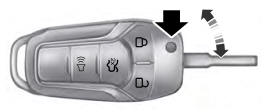Ford Explorer: Seatbelt Systems / Description and Operation - Seatbelt Systems - System Operation and Component Description
System Operation
Emergency Locking Retractor (ELR)
All
retractors have an Emergency Locking Retractor (ELR) mode, which is a
vehicle-sensitive feature designed to activate and lock the seatbelt
webbing during hard braking, cornering, or an impact of approximately 24
km/h (15 mph). The Emergency Locking Retractor (ELR) feature helps
reduce the forward movement of the driver and passengers. For testing,
see Functional Test - Seatbelt Retractor, Road Test Inspection.
Refer to: Seatbelt Systems (501-20A Seatbelt Systems, Diagnosis and Testing).
Automatic Locking Retractor (ALR)
The
Automatic Locking Retractor (ALR) mode is used when locking a child
seat in any passenger seating position. The Automatic Locking Retractor
(ALR) mode automatically activates when the seatbelt webbing is fully
extracted from the retractor and then allowed to retract. As the
seatbelt webbing retracts back onto the spool, an audible clicking sound
is made, indicating the seatbelt retractor is in Automatic Locking
Retractor (ALR) mode and the seatbelt webbing cannot pull back out of
the seatbelt retractor. The Automatic Locking Retractor (ALR) mode
disengages when the webbing is allowed to fully retract back into the
retractor. For testing, see Functional Test - Seatbelt Retractor,
Automatic Locking Retractor (ALR) Mode.
Refer to: Seatbelt Systems (501-20A Seatbelt Systems, Diagnosis and Testing).
Seatbelt Warning Chime and Indicator
For seatbelt warning chime and indicator operation,
Refer to: Warning Chimes - System Operation and Component Description (413-01 Instrumentation, Message Center and Warning Chimes, Description and Operation).
To diagnose the seatbelt warning chime and indicator,
Refer to: Instrumentation, Message Center and Warning Chimes (413-01 Instrumentation, Message Center and Warning Chimes, Diagnosis and Testing).
Belt-Minder®
For Belt-Minder® operation,
Refer to: Warning Chimes - System Operation and Component Description (413-01 Instrumentation, Message Center and Warning Chimes, Description and Operation).
To diagnose the Belt-Minder® feature,
Refer to: Instrumentation, Message Center and Warning Chimes (413-01 Instrumentation, Message Center and Warning Chimes, Diagnosis and Testing).
To activate or deactivate the Belt-Minder® feature,
Refer to: Seatbelt Minder Deactivating/Activating (413-01 Instrumentation, Message Center and Warning Chimes, General Procedures).
Component Description
Child Safety Seat Tether Anchor
Child safety seat tether anchors are provided at all second and third row seat positions. They are part of the seat backrest frame and cannot be serviced separately. Install a new backrest frame.
If a child safety seat was in use during a collision, inspect the child safety seat tether anchor and mounting areas and restore the vehicle to the original production configuration.
Child Safety Seat Tether Anchor - Lower Anchors and Tethers for Children (LATCH)
Lower Anchors and Tethers for Children (LATCH) are located at the second row outboard seating positions and at both third row seating positions. For second row seating, they are part of the seat cushion frame. For third row, they are part of the seat backrest frame. LATCH cannot be serviced separately. Install a new seat cushion frame or seat backrest frame.
If a child safety seat was in use during a collision, inspect the LATCH and restore the vehicle to the original production configuration.
 Diagnosis and Testing - Seatbelt Systems
Diagnosis and Testing - Seatbelt Systems
Symptom Chart(s)
Preliminary Inspection
Diagnostics in this manual assume a certain skill level and knowledge of Ford-specific diagnostic practices...
Other information:
Ford Explorer 2020-2025 Service Manual: General Procedures - Transmission Fluid Level Check
Check NOTICE: The vehicle should not be driven if the transmission fluid level is low. Internal failure could result. NOTE: If the vehicle has been operated for an extended period at high highway speeds, in city traffic, during hot weather or while pulling a trailer, the transmission fluid must cool down to obtain an accurate reading...
Ford Explorer 2020-2025 Service Manual: General Procedures - Fluorescent Dye Leak Detection - Vehicles With: R1234YF Refrigerant
Special Tool(s) / General Equipment UV Leak Detector Electronic Leak Detector Leak detection Vehicles with air conditioning Review next note for important refrigerant system dye information. NOTE: Fluorescent refrigerant system dye is added to the refrigerant system at the factory to assist in refrigerant system leak diagnosis using a Rotunda-approved UV lamp..
Categories
- Manuals Home
- 6th Generation Explorer Owners Manual
- 6th Generation Explorer Service Manual
- General Procedures - Brake Service Mode Activation and Deactivation
- Automatic Transmission - 10-Speed Automatic Transmission – 10R60
- Auxiliary Power Points
- New on site
- Most important about car
Integrated Keyhead Transmitter (If Equipped)
Use the key blade to start your vehicle and unlock or lock the driver door from outside your vehicle. The integrated keyhead transmitter functions as a programmed ignition key that operates all the locks and starts your vehicle, as well as a remote control.


